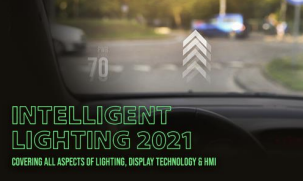REDMOND, Wash. – September 27, 2021 – Radiant Vision Systems, a leading provider of test and measurement solutions for the automotive industry, announces that it will present at Intelligent Lighting & Displays 2021—a free, half-day virtual event organized by Automotive IQ that brings together experts to discuss trends and applications of light inside and outside the car of tomorrow.

Image credit: Radiant Vision Systems
The web event will be broadcast live on Tuesday, October 5, from 9:00 A.M. to 12:30 P.M. Eastern Time (ET) (15:00-18:30 Central European Time (CET)) with presentations from Matt Scholz, Automotive Business Leader at Radiant, and subject matter experts from Dow, Groupe PSA, and Arrival. Scholz will kick off the broadcast presenting Session One “Characterizing the Effects of Windshields on Head-Up Displays: New Demands for Visual Inspection” from 9:00 to 9:50 A.M. ET (15:00 to 15:50 CET), including a 30-minute presentation followed by an audience Q&A session.
In a short time, head-up displays (HUD) have evolved from simple, fixed-distance projections to dynamic virtual images that align in real-time with the depths and locations of objects outside the vehicle. This application of augmented-reality (AR HUD) technology requires increased HUD performance over a wider field of view, ensuring virtual images are projected at any point on the windshield where a driver may benefit from supplemental information about the outside environment. As HUDs comprise more of the windshield, the windshield gains more influence over the visual performance of HUD projections. An emerging quality concern for automotive OEMs and glass suppliers is the integrity of the windshield and developing ways to evaluate defects in HUD projections to determine corrections for windshield production.
“The windshield acts as an optical component of an integrated HUD system,” states Scholz. “It directs multiple emissions of light from the HUD projector and aligns them as a virtual image that appears to the driver at a perceived distance in front of the vehicle. Because the windshield is made up of multiple layers of laminated glass, there is some room for error as light passes through multiple surfaces and is reflected to the driver’s eyes. If there is misalignment of these reflections, the HUD image can appear to be duplicated—a defect called Ghosting. In addition, windshields are not flat surfaces, but are manufactured with some horizontal and vertical curvature. Anomalies in this curvature can not only influence Ghosting, but can also cause Distortion defects, which manifest as warped or magnified virtual images. These defects have become a greater concern with the development of HUDs toward larger virtual images and larger fields of view that occupy more of the windshield’s surface area.”
To evaluate the integrity of the windshield for visual HUD performance, automakers have begun to specify inspection criteria for their suppliers. Unique test patterns and inspection routines have been developed to evaluate specific defects, including Ghosting and the various manifestations of Distortion. Calculations used to measure the characteristics of each defect are becoming extremely detailed, with the goal of providing glass manufacturers with more meaningful metrics to enable fine-tuning of their glass production processes.
“Automakers are enforcing strict quality parameters on windshield glass manufacturers to ensure the integrity of the windshield for visual quality in HUDs. As these requirements become more complex, traditional inspection equipment like machine vision cameras and software are no longer capable of performing inspection tasks to the full extent necessary for precise metrology. Often, these traditional systems require custom development of software analysis functions and data output, which are difficult to adapt to new criteria, and often extremely inefficient. Manufacturers need more powerful inspection equipment to continue to ensure HUD quality at speed and with as much built-in capability as possible.”
During the upcoming web presentation at Intelligent Lighting & Displays 2021, presenter Matt Scholz will discuss HUD defects introduced by windshield glass and specifications for measurement. The webinar will compare visual inspection equipment and pose considerations for choosing a vision system with advantages for HUD testing and characterizing the effects of windshield glass. Scholz will end the presentation by sharing a case study with Radiant customer CP Industries, and will share analysis examples from Radiant’s HUD measurement software. Scholz brings over 10 years of experience working on automotive metrology applications at all levels of the automotive supply chain and has partnered with manufacturers worldwide to build solutions that ensure their success.
For more information about Radiant’s presentation or to register for the free, half-day virtual event on October 5, visit www.automotive-iq.com/events-intelligent-lighting-online.
About Radiant Vision Systems
Radiant Vision Systems works with world-class brands and manufacturers to deliver creative visual inspection solutions that improve quality, reduce costs, and increase customer satisfaction. Radiant’s legacy of technology innovation in photometric imaging and worldwide install base date back more than 25 years and address applications from consumer electronics to automotive manufacturing. Radiant Vision Systems product lines include TrueTest™ automated visual inspection software for quality control, and ProMetric® imaging colorimeters, photometers, and light source measurement systems. Radiant is headquartered in Redmond, Washington, USA, with strategic offices in California, Michigan, China, South Korea, and Vietnam. Radiant has been a part of Konica Minolta’s Sensing Business Unit since August 2015. For more information, visit www.RadiantVisionSystems.com.